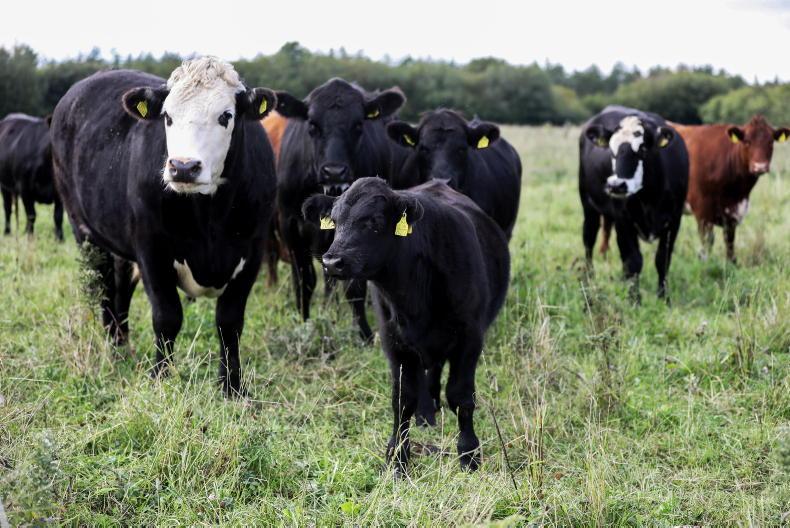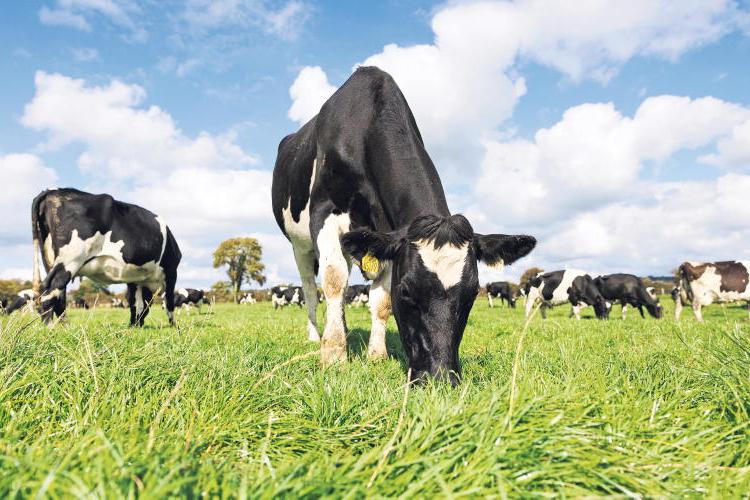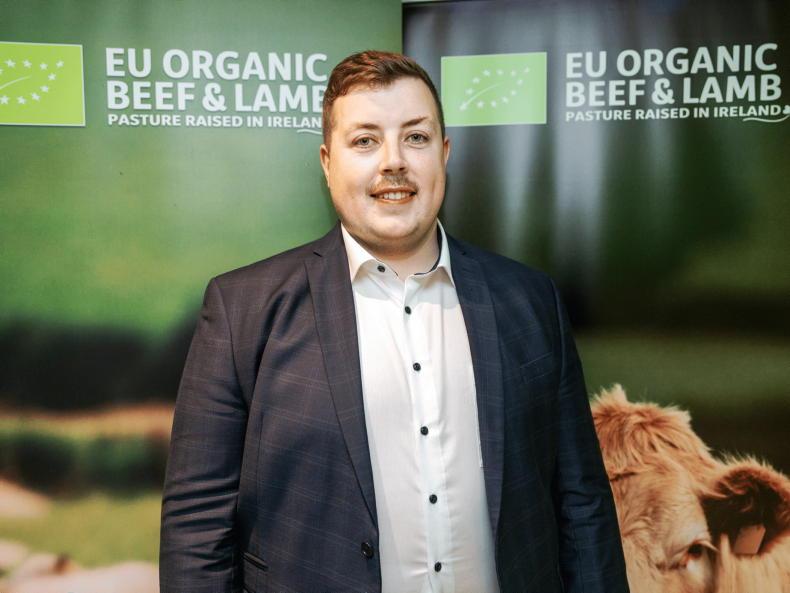Since 2013, nearly 300,000 carbon footprints have been generated for Irish beef and dairy farm members. To calculate the carbon footprint, Bord Bia uses a carbon footprint model developed by Teagasc and accredited by the Carbon Trust.
Carbon footprinting has been hugely significant in supporting the marketing and promotion of Irish beef and dairy around the world.
In recent years, the recommended international methodologies for quantifying greenhouse gas emissions at a macro level have been refined. Last year, the dairy carbon footprint was updated to reflect the most recent recommended methodologies. The same model update is currently being applied to the beef carbon footprint in co-operation with ICBF and Teagasc.
The update to the model will mean that beef farmers audited using the new model from next year will see a change in their carbon footprint (as reported in their Farmer Feedback Report).
Over 300,000 historical beef carbon footprint calculations have been re-run against the new model. Preliminary results indicate the average beef carbon footprint will reduce by 12% from 10.45kg to 9.2kg CO2 /kg of live weight gain (LWG). It is important to note that this decrease reflects the new model, rather than changes at farm-level, and does not affect national agri-emissions carbon reduction targets.
In order to compare like with like, each farm’s carbon footprint from its previous audit will also be adjusted to the new model. Therefore, a farmer can note improvements to their carbon footprint by the percentage change from the previous audit. To view your carbon footprint on your farmer feedback report, please log on to or scan the QR code below left and enter your herd number and PIN. (There is a ‘forget PIN’ option, which texts your PIN to the mobile number you have provided to Bord Bia. For further queries contact the Bord Bia helpdesk on 01-524 0410.)
Annual carbon footprints
To calculate a farm’s carbon footprint, Bord Bia requires four sources of data, outlined below. It has data sharing and transfer arrangements in place with industry stakeholders to reduce the burden of data collection on the farmer:
1 Animal Identification and Movements Database from the Department of Agriculture.
2. Daily liveweight gain information from ICBF (for beef only).
3 Milk production data from dairy processors (dairy only).
4 The sustainability survey, which farmers must complete themselves before their audit date.

\ Lorraine O'Sullivan
As the audit cycle is every 18 months, farmers only complete the sustainability survey once every 18 months. As a result, a farm’s carbon footprint can only be updated as part of this cycle. From next year, farmers will have the option of completing their sustainability survey every 12 months, to receive an annual carbon footprint. This will be optional for all beef and dairy members, allowing farmers to track their progress on an annual basis. Farmers opting for 12-month intervals can choose any date throughout the year to complete their sustainability survey, while farmers who remain in the 18-month cycle must complete before their audit.
Standard development
Bord Bia is developing a new primary producer standard which will merge existing farm and producer standards. The aim of this new approach is to improve the efficiency of the standard development process in Bord Bia. Benefits include more consistent auditing, less overall time required in the updating of standards, and improved benchmarking against international standards. The standard is currently being reviewed by a panel of technical experts across a range of subject matters including animal health and welfare, biodiversity, and sustainability. A special Technical Advisory Committee (TAC) for this new standard will convene in early 2023 with an ambition to launch in 2024.
New measures
Rory Mannion, Origin Green agri-sustainability specialist, on new tools to assist farmers with farm sustainability measures.
Farmer eLearning
In October last year, Bord Bia launched a free online learning tool for farm members consisting of short modules providing information and support to farmers on how to implement best practice farm sustainability.
So far, almost 3,700 farm scheme members have registered for the Farm Sustainability Learning Hub. Seven modules are currently available covering topics such as water quality, soil health, energy efficiency, farmland biodiversity, and greenhouse gases. A new animal welfare module is currently in development in collaboration with Animal Health Ireland, to launch in early 2023. A second new module on pollinator friendly farming will also launch next year.
To enroll, visit, farm.bordbia.ie or scan the QR code using a smartphone camera.
Farm sustainability planning tool
Bord Bia is developing a farm sustainability planning tool in collaboration with Teagasc and ICBF.
The purpose of the tool is to allow farmers and advisers can create farm-specific sustainability plans. The platform will recommend sustainability actions that reflect current best-practice industry guidelines (eg the Teagasc Marginal Abatement Cost Curve), which farmers can add to their farm plans. This will be piloted throughout the coming months with Teagasc advisers and farmers. In future, the tool will be accessible by farmers through a broader farmer emissions platform being developed by Teagasc and ICBF.
Since 2013, nearly 300,000 carbon footprints have been generated for Irish beef and dairy farm members. To calculate the carbon footprint, Bord Bia uses a carbon footprint model developed by Teagasc and accredited by the Carbon Trust.
Carbon footprinting has been hugely significant in supporting the marketing and promotion of Irish beef and dairy around the world.
In recent years, the recommended international methodologies for quantifying greenhouse gas emissions at a macro level have been refined. Last year, the dairy carbon footprint was updated to reflect the most recent recommended methodologies. The same model update is currently being applied to the beef carbon footprint in co-operation with ICBF and Teagasc.
The update to the model will mean that beef farmers audited using the new model from next year will see a change in their carbon footprint (as reported in their Farmer Feedback Report).
Over 300,000 historical beef carbon footprint calculations have been re-run against the new model. Preliminary results indicate the average beef carbon footprint will reduce by 12% from 10.45kg to 9.2kg CO2 /kg of live weight gain (LWG). It is important to note that this decrease reflects the new model, rather than changes at farm-level, and does not affect national agri-emissions carbon reduction targets.
In order to compare like with like, each farm’s carbon footprint from its previous audit will also be adjusted to the new model. Therefore, a farmer can note improvements to their carbon footprint by the percentage change from the previous audit. To view your carbon footprint on your farmer feedback report, please log on to or scan the QR code below left and enter your herd number and PIN. (There is a ‘forget PIN’ option, which texts your PIN to the mobile number you have provided to Bord Bia. For further queries contact the Bord Bia helpdesk on 01-524 0410.)
Annual carbon footprints
To calculate a farm’s carbon footprint, Bord Bia requires four sources of data, outlined below. It has data sharing and transfer arrangements in place with industry stakeholders to reduce the burden of data collection on the farmer:
1 Animal Identification and Movements Database from the Department of Agriculture.
2. Daily liveweight gain information from ICBF (for beef only).
3 Milk production data from dairy processors (dairy only).
4 The sustainability survey, which farmers must complete themselves before their audit date.

\ Lorraine O'Sullivan
As the audit cycle is every 18 months, farmers only complete the sustainability survey once every 18 months. As a result, a farm’s carbon footprint can only be updated as part of this cycle. From next year, farmers will have the option of completing their sustainability survey every 12 months, to receive an annual carbon footprint. This will be optional for all beef and dairy members, allowing farmers to track their progress on an annual basis. Farmers opting for 12-month intervals can choose any date throughout the year to complete their sustainability survey, while farmers who remain in the 18-month cycle must complete before their audit.
Standard development
Bord Bia is developing a new primary producer standard which will merge existing farm and producer standards. The aim of this new approach is to improve the efficiency of the standard development process in Bord Bia. Benefits include more consistent auditing, less overall time required in the updating of standards, and improved benchmarking against international standards. The standard is currently being reviewed by a panel of technical experts across a range of subject matters including animal health and welfare, biodiversity, and sustainability. A special Technical Advisory Committee (TAC) for this new standard will convene in early 2023 with an ambition to launch in 2024.
New measures
Rory Mannion, Origin Green agri-sustainability specialist, on new tools to assist farmers with farm sustainability measures.
Farmer eLearning
In October last year, Bord Bia launched a free online learning tool for farm members consisting of short modules providing information and support to farmers on how to implement best practice farm sustainability.
So far, almost 3,700 farm scheme members have registered for the Farm Sustainability Learning Hub. Seven modules are currently available covering topics such as water quality, soil health, energy efficiency, farmland biodiversity, and greenhouse gases. A new animal welfare module is currently in development in collaboration with Animal Health Ireland, to launch in early 2023. A second new module on pollinator friendly farming will also launch next year.
To enroll, visit, farm.bordbia.ie or scan the QR code using a smartphone camera.
Farm sustainability planning tool
Bord Bia is developing a farm sustainability planning tool in collaboration with Teagasc and ICBF.
The purpose of the tool is to allow farmers and advisers can create farm-specific sustainability plans. The platform will recommend sustainability actions that reflect current best-practice industry guidelines (eg the Teagasc Marginal Abatement Cost Curve), which farmers can add to their farm plans. This will be piloted throughout the coming months with Teagasc advisers and farmers. In future, the tool will be accessible by farmers through a broader farmer emissions platform being developed by Teagasc and ICBF.










SHARING OPTIONS